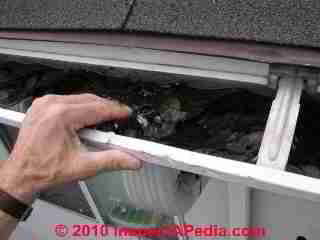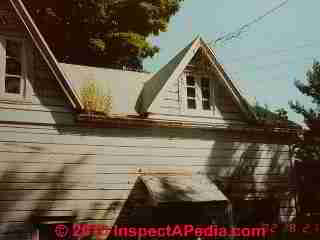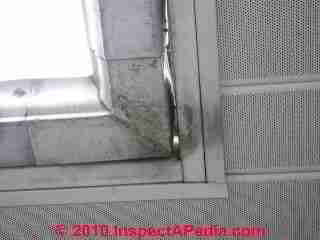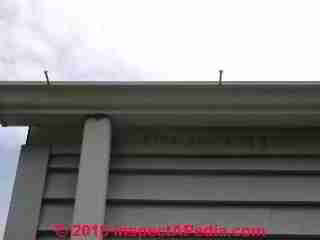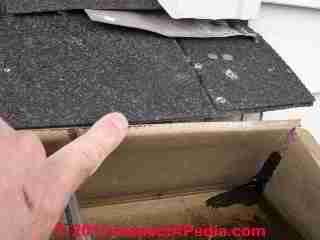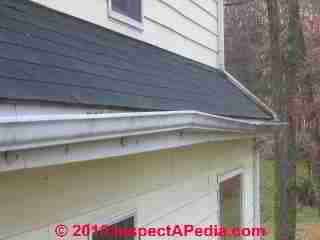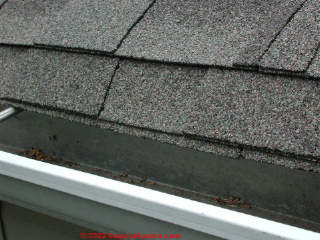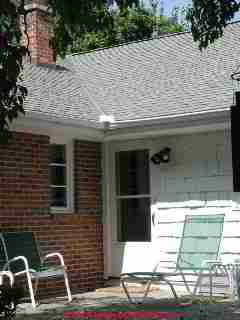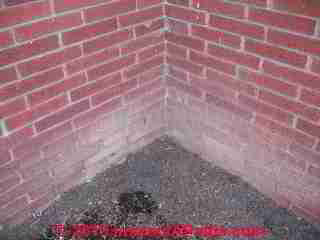 Gutter Defects, Leaks, Problems
Gutter Defects, Leaks, Problems
Photo guide to gutter problems
- POST a QUESTION or COMMENT about gutter leaks, clogs, coming loose, overflowing, other defects: diagnosis, repair, prevention
Roof gutter defects & how they cause building leaks, damage, or wet basements & crawl spaces.
Here we list and describe gutter problems and defects including clogged gutters, leaky roof gutters, overflowing gutters, sagging, loose, poorly-sloped or damaged gutters and other roof drainage system problems.
InspectAPedia tolerates no conflicts of interest. We have no relationship with advertisers, products, or services discussed at this website.
- Daniel Friedman, Publisher/Editor/Author - See WHO ARE WE?
Common Gutter Defects & Causes of Leakage & Wet Basements / Crawl Spaces
[Click to enlarge any image]
Article Series Contents
The two most common building leaks that cause wet basements or crawl areas originate at the roof drainage system:
- Gutter defects: Clogged, overflowing gutters; also gutters that are falling off, improperly sloped, or leaky - discussed here at GUTTER DEFECTS LIST
- Downspout defects: Downspouts that are emptying too close to the building; also downspouts or "leaders" that have been disconnected or were improperly connected . Downspout defects are detailed at Roof Downspout or Leader Defects.
Roof Gutter Defects List
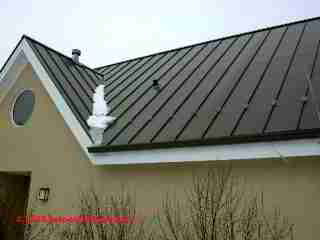 Our list of common gutter defects shown just below is followed by illustrations or photographs of many of these conditions.
Our list of common gutter defects shown just below is followed by illustrations or photographs of many of these conditions.
- Backflowing gutters: water falling off the roof edge runs behind the gutter or between the gutter and the building fascia rather than falling into the gutter.
See BACKFLOWING GUTTERS. - Clogged gutters lead to overflows, water spillage around the building, water entry, as well as gutter damage. G
utter screens and shields may be installed to reduce the frequency of gutter cleaning, but these components are by no means a magic bullet nor a substitute for regular gutter inspection and cleaning, and if not properly installed they make gutter cleaning more difficult.
See Gutter Screens and see Gutter Caps & Shields. - Corroded, leaky gutters, most common with copper gutters and galvanized steel gutters.
Examples are shown at Galvanized Roof Gutters. - Downspout defects: Details about gutter and leader defects are at Roof Downspout or Leader Defects.
- Roof drip edge errors: roof drip edge behind gutter - sends roof runoff behind rather than into gutter; roof drainage runs behind the gutter, spilling by the building.
See GUTTER INSTALL ERRORS.
Also see DRIP EDGE FLASHING for ROOFS - Improperly sloped gutters - overflow rather than draining, added weight increases sag and loosening or falling-off gutters. Check that the gutters are properly sloped
Roof gutters should slope at least 1-inch in every 200 inches of run; also see SAGGING GUTTERS - Missing gutters: fallen off, or never installed at some roof edges where needed; missing from upper or secondary roofs.
Also see GUTTER DEFECTS, MORE and see
DOWNSPOUT DEFECTS, MORE - Loose gutters, failing hangers, falling off, or sagging; insufficient number of gutter supports or hangers; as gutters pull away from the building roof drainage runs behind the gutter, spilling by the building.
See LOOSE GUTTERS. - "Gutter Overshooting" or roof spillage passing over the gutter due to roof slope, gutter placement, or high-volume drainage at roof valleys, or caused by shingles extended too far into gutters.
Details are at OVERSHOOTING GUTTERS. - Gutter Painting needed: galvanized steel gutters and downspouts need to be kept painted to resist corrosion and leakage. Painting the gutter interior surface and using moisture-resistant paints may extend the gutter life.
- Gutter sagging: gutters that are sagging or lack slope towards the downspouts will drain too slowly and become heavy with water and debris, leading to loose or falling gutters as well.
Details are at SAGGING GUTTERS. - Gutter slope: gutters lack adequate slope, are too flat, or slope the wrong way, away from downspout drains
- Undersized gutters - too small for the area of roof drained.
See GUTTER SIZES. - Ice damaged gutters: ice knocks gutters off of the building (photo above shows snow guards to help prevent ice damage to gutters).
See SNOW & ICE DAMAGE to GUTTERS.
Clogged, Overflowing Gutters - Inspect & Clean Gutters Regularly
If you see shrubs growing in your gutters (below) you know the roof drainage system has not been cleaned in a long time - look for basement water entry, building wall damage or rot, and related water problems.
Inspecting from a ladder you may also find that even a small handful of leaves and crud can block the downspout connection (also called an "end drop") leading to gutter overflowing and building water entry (below).
Loose Gutters
Take a look around your building for gutters that are actually falling off (or have already fallen off - below left) but also look for loose gutter spikes or brackets (below right).
Loose gutters, before they have fallen away from the building, are permitting roof runoff to miss the gutter and run down building walls, enter soffits or eaves (rot), and by falling close to the building foundation wall, the water concentrating there is likely to enter the building basement or crawl area.

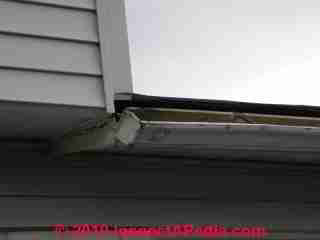
Try looking "up" from below the building's gutter system (photo below left). If you see daylight between the back side of the building gutter and the fascia board, check further for gutter backflow, leaks, or simply a gutter that has begun to pull away from the building.
A second easy-to-spot loose gutter warning is the gutter spikes projecting out from the gutter edge (below right).
Watch out: Don't forget to inspect the gutters closely from the roof edge as well.
A loose gutter may be out past the shingle edge or drip edge but may not be visible from the ground. When it rains, water runs down the building wall at this point.
Inadequate or Improper Gutter Slope
Improperly-sloped gutters will not empty properly and in heavy rain are likely to overflow.
Check that the roof gutters are properly sloped, both in the pitch and in the direction of pitch towards the gutter drains or downspouts.
Our photo (left) shows a desperate attempt to get back proper slope and drainage in a long gutter run that had sagged at its center.
On long gutter runs attached to a roof with a rather short fascia board, it can be difficult to obtain adequate slope.
Roof gutters should slope at least 1-inch in every 200 inches of run; also see SAGGING GUTTERS since even if the gutters were originally installed with proper slope they may have sagged due to loading from clogs, water, ice or debris.
But if the total length of the gutter run is long and the fascia is not very tall, say 6 to 8", then it may be impossible to get adequate gutter slope throughout its total run, even if we push the high end of the gutter right up against the shingle overhang and drop the low end of the gutter to the very bottom of the fascia. If your roof has this problem it may be necessary to add additional downspouts along the gutter's run and/or to divide the total gutter run into shorter lengths.
Then re-start gutter sections higher on the fascia.
Some causes of improper gutter slope include:
- Improper original installation: gutters installed "flat" or sloping away from the downspout drain
- Improper original installation: gutters lacked adequate number of supports or hangers to prevent sagging. See GUTTER HANGERS and also see SAGGING GUTTERS.
- Gutter slope changed due to gutter movement from
- Damage - falling limbs, ladders, work on roof
- Weight of water from clogged gutters
- Weight of snow or ice in gutters
- Pushing or movement of gutter caused by ice or snow
Gutter "Overshoot" - Water Flows Over or Past Rather Than Into Roof Gutters
Gutter Mounting Position Affects Gutter Performance & Resistance to Snow & Ice Damage
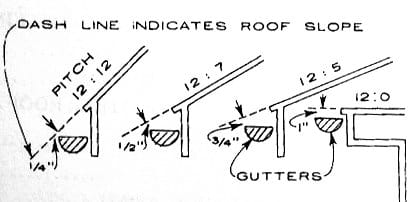
The sketch at left shows optimum gutter placement at the building eaves to catch water spilling off of the roof. As you can see, the gutter location depends in part on roof pitch.
Proper gutter placement is especially important in freezing climates in order to reduce the tendency of snow and ice to "push" the gutters off of the building.
Gutter Overshoot from Too Much Shingle Overhang at the roof Eaves
Gutter overshoot refers to water that runs down the roof and over or past the roof gutters rather than into them. Some common causes of gutter overshoot include:
- Excessive roof shingle overhang (illustrated below). This roofing installation error not only interferes with good gutter operation, it also risks breakage along the roof shingle edges.
It's easy to fix this mistake: be sure that roof drip edge as been installed to support the extension of shingle beyond the very edge of the roof deck, then trim the shingles so that no more than 1/2" of shingle material extends past the edge of the drip edge itself.
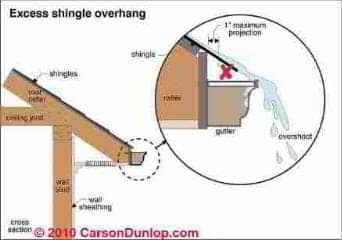
The sketch above shows what happens when roof shingles extend too far past the edge of the roof deck and too far into the roof gutter. The sketch does not show what happens if the roof shingle projection past the roof deck is not supported by drip edge: with time the roof shingles curl down into the gutter itself, and sometimes crack or even break off at that point.
Sketch courtesy of Carson Dunlop Associates, a Toronto home inspection, education & report writing tool company [ carsondunlop.com ].
- Roof Valley Overshoot: gutters too small in width for volume of roof runoff; this problem is most frequent below roof valleys where a higher volume of water may be running down-roof in heavy rains.
If your building design includes inside corners of abutting roof slopes, inspect the ground below the valley for evidence of roof valley overshoot (you'll see an area of soil washed away, siding or wall damage from rain splash-up, or building water entry in the basement or crawl space at this location. Spilling water from a roof valley into an inside building corner also tends to increase water entry because the angled foundation walls tend to form a water trap at that location.
Install a Gutter Defelector to Cure Gutter or Roof Valley Runoff Overshooting the Gutters
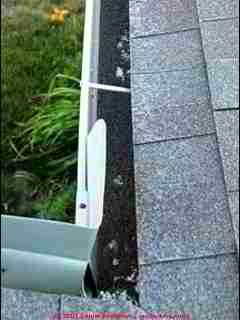
Our roof gutter deflector photos (above) show a deflector installed at the end of a roof valley (above left) and at a different home, evidence of spillage and splash-up below a roof valley due to gutter overshoot (above right).
Take a closer look at the gutters in our photo at left where a valley spillage gutter deflector is installed: notice all those mineral granules.
This roof had been damaged by hail. Our OPINION was that the extra loss of mineral granules meant that the roof would probably have a shorter remaining life than usual.
Here is another closeup photo of a gutter deflector installed below a roof valley.
Roof Gutter or Eaves Trough Inspection & Repair Articles
- GUTTERS & DOWNSPOUTS - home
- DOWNSPOUT / LEADER DEFECTS
- GUTTER CAPS
- GUTTER DEFECTS LIST
- GUTTER HANGERS
- GUTTER REPAIR, LEAKY JOINT
- GUTTER SCREENS
- GUTTER SIZES
- GUTTER TYPES
...
Continue reading at GUTTER DEFECTS, MORE or select a topic from the closely-related articles below, or see the complete ARTICLE INDEX.
Suggested citation for this web page
GUTTER DEFECTS LIST at InspectApedia.com - online encyclopedia of building & environmental inspection, testing, diagnosis, repair, & problem prevention advice.
Or see this
INDEX to RELATED ARTICLES: ARTICLE INDEX to GUTTERS & DOWNSPOUTS
Or use the SEARCH BOX found below to Ask a Question or Search InspectApedia
Ask a Question or Search InspectApedia
Try the search box just below, or if you prefer, post a question or comment in the Comments box below and we will respond promptly.
Search the InspectApedia website
Note: appearance of your Comment below may be delayed: if your comment contains an image, photograph, web link, or text that looks to the software as if it might be a web link, your posting will appear after it has been approved by a moderator. Apologies for the delay.
Only one image can be added per comment but you can post as many comments, and therefore images, as you like.
You will not receive a notification when a response to your question has been posted.
Please bookmark this page to make it easy for you to check back for our response.
IF above you see "Comment Form is loading comments..." then COMMENT BOX - countable.ca / bawkbox.com IS NOT WORKING.
In any case you are welcome to send an email directly to us at InspectApedia.com at editor@inspectApedia.com
We'll reply to you directly. Please help us help you by noting, in your email, the URL of the InspectApedia page where you wanted to comment.
Citations & References
In addition to any citations in the article above, a full list is available on request.
- Mark Cramer Inspection Services Mark Cramer, Tampa Florida, Mr. Cramer is a past president of ASHI, the American Society of Home Inspectors and is a Florida home inspector and home inspection educator. Mr. Cramer serves on the ASHI Home Inspection Standards. Contact Mark Cramer at: 727-595-4211 mark@BestTampaInspector.com
- John Cranor [Website: /www.house-whisperer.com ] is an ASHI member and a home inspector (The House Whisperer) is located in Glen Allen, VA 23060. He is also a contributor to InspectApedia.com in several technical areas such as plumbing and appliances (dryer vents). Contact Mr. Cranor at 804-873-8534 or by Email: johncranor@verizon.net
- Building Pathology, Deterioration, Diagnostics, and Intervention, Samuel Y. Harris, P.E., AIA, Esq., ISBN 0-471-33172-4, John Wiley & Sons, 2001 [General building science-DF - ** Particularly useful text **
- Dampness in buildings, Diagnosis, Treatment, Instruments, T.A. Oxley & E.G. Gobert, ISBN 0-408-01463-6, Butterworths, 1983-1987 [General building science-DF]
- In addition to citations & references found in this article, see the research citations given at the end of the related articles found at our suggested
CONTINUE READING or RECOMMENDED ARTICLES.
- Carson, Dunlop & Associates Ltd., 120 Carlton Street Suite 407, Toronto ON M5A 4K2. Tel: (416) 964-9415 1-800-268-7070 Email: info@carsondunlop.com. Alan Carson is a past president of ASHI, the American Society of Home Inspectors.
Thanks to Alan Carson and Bob Dunlop, for permission for InspectAPedia to use text excerpts from The HOME REFERENCE BOOK - the Encyclopedia of Homes and to use illustrations from The ILLUSTRATED HOME .
Carson Dunlop Associates provides extensive home inspection education and report writing material. In gratitude we provide links to tsome Carson Dunlop Associates products and services.


